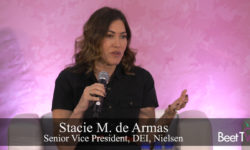SANTA MONICA — What does “programmatic” mean when it comes to television, and how likely is it to reach higher heights?
The tech-mediated trading of digital ads first hit display with automation and auctions top of mind.
But, in this video interview with Beet.TV, Jake Richardson, Director, TV Partnerships, The Trade Desk, says that can’t happen in the TV world.
The Trade Desk is a software provider with a demand-side platform (DSP) bringing direct access to publisher inventory and support for new identity schemes.
Normalizing programmatic
Speaking at Beet Retreat Santa Monica with Tameka Kee, Richardson, who heads the company’s connected TV initiatives, says selling into TV is different from other channels.
“When you say ‘programmatic’, (TV buyers’) eyes start to glaze over,” he says.
“What we’ve tried to move away from as The Trade Desk is thinking about programmatic as one of the things on your marketing plan. Programmatic is just a vehicle for execution.
“It’s an ability for you to take your buys, wherever they may be – cross-channel, cross-publisher – put them into one place as a marketer, and then allow you to target, measure and report against your audience across the open internet.”
Growth forecast
EMarketer had forecast US spend on connected TV (CTV) ad channels via programmatic methods would hit $14.3 billion in 2022).
That is actually the slowest growth in the method seen in years, but it is a channel that is maturing, as more ad buyers switch on to the new channels and new capabilities on offer.
It is about 20% of the total $68.35 billion US TV ad spend eMarketer forecast separately for 2022.

Different message
Key to how fast programmatic TV spend grows is the extent to which vendors like Richardson’s The Trade Desk can adapt their message for this industry.
“It’s just a very different channel,” he acknowledges. “There’s more scarcity, it’s more premium, there’s more attentiveness.
“So we’ve had to change the way that we think, talk and advertise programmatically at our company. If we just came in and said, ‘Hey, we’re the tech folks and we understand everything about auctions’, I wouldn’t be up here right now.
“That’s not how TV works. TV is a relationship-based experience both from the buy- and the sell-side, and it’s really about the consumer. It’s about the brand, it’s about the message, it’s about the story that you’re able to tell.”
Jake Richardson, director of TV partnerships at @TheTradeDesk, shares his views about programmatic advertising's growth in TV and how media companies can protect their first-party data: https://t.co/cACv65EclP #programmaticadvertising #mediabuying #dsp #adtech #adsales $TTD $DIS pic.twitter.com/PAQbkeni7F
— Andy Plesser (@Beet_TV) November 1, 2022
Still scarce, still special
Richardson says TV will remain “supply-scarce”, unlike channels like display, online, video and mobile, because it will always be able to compete on premium content.
“There’s no way that connected television can be as prolific as display for two reasons,” he says:
- “Attentiveness. You really can’t scroll through 15 shows in 10 minutes and then be done with your experience like you can on the web or in a mobile app.
- “Tolerance. Customers are not going to tolerate more ads than content.”
A place for performance
Programmatic TV capabilities include targeting a viewer or household, regardless of the channel or service or content they are watching.
“Content always used to be a proxy for audience,” Richardson says. “What if it turned out (a Rolex prospect) watching on any host of things rather than just The Golf Channel?”
But he is realistic that programmatic TV won’t quickly get to the point display ads are often at, of pricing based on actual performance outcomes.
“We can’t just say, ‘Great, let’s just do everything performance-based’,” Richardson ads. “There is a place and time for these deals.”
You are watching coverage of Beet Retreat Santa Monica 2022, presented by Ampersand, MiQ, Nielsen, PubMatic, T-Mobile Advertising Solutions and The Trade Desk. For more videos from the Beet Retreat, please visit this page.














































